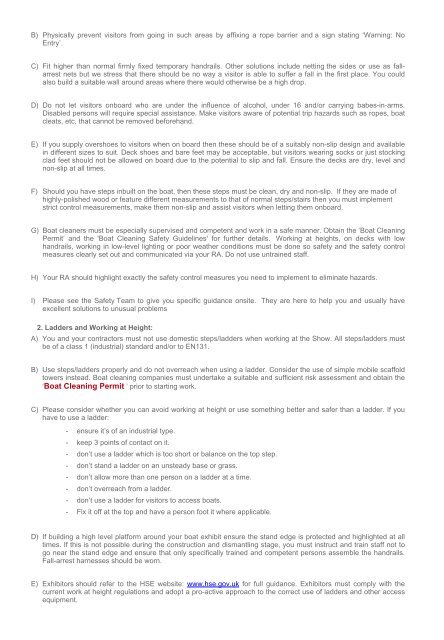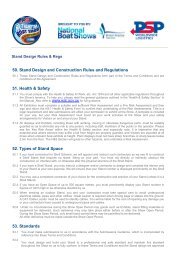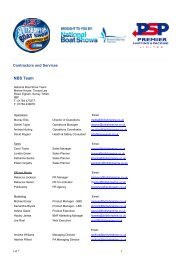Health & Safety Types of Stand Build and Submission Requirements
Health & Safety Types of Stand Build and Submission Requirements
Health & Safety Types of Stand Build and Submission Requirements
You also want an ePaper? Increase the reach of your titles
YUMPU automatically turns print PDFs into web optimized ePapers that Google loves.
B) Physically prevent visitors from going in such areas by affixing a rope barrier <strong>and</strong> a sign stating ‘Warning: NoEntry’.C) Fit higher than normal firmly fixed temporary h<strong>and</strong>rails. Other solutions include netting the sides or use as fallarrestnets but we stress that there should be no way a visitor is able to suffer a fall in the first place. You couldalso build a suitable wall around areas where there would otherwise be a high drop.D) Do not let visitors onboard who are under the influence <strong>of</strong> alcohol, under 16 <strong>and</strong>/or carrying babes-in-arms.Disabled persons will require special assistance. Make visitors aware <strong>of</strong> potential trip hazards such as ropes, boatcleats, etc, that cannot be removed beforeh<strong>and</strong>.E) If you supply overshoes to visitors when on board then these should be <strong>of</strong> a suitably non-slip design <strong>and</strong> availablein different sizes to suit. Deck shoes <strong>and</strong> bare feet may be acceptable, but visitors wearing socks or just stockingclad feet should not be allowed on board due to the potential to slip <strong>and</strong> fall. Ensure the decks are dry, level <strong>and</strong>non-slip at all times.F) Should you have steps inbuilt on the boat, then these steps must be clean, dry <strong>and</strong> non-slip. If they are made <strong>of</strong>highly-polished wood or feature different measurements to that <strong>of</strong> normal steps/stairs then you must implementstrict control measurements, make them non-slip <strong>and</strong> assist visitors when letting them onboard.G) Boat cleaners must be especially supervised <strong>and</strong> competent <strong>and</strong> work in a safe manner. Obtain the ‘Boat CleaningPermit’ <strong>and</strong> the 'Boat Cleaning <strong>Safety</strong> Guidelines' for further details. Working at heights, on decks with lowh<strong>and</strong>rails, working in low-level lighting or poor weather conditions must be done so safety <strong>and</strong> the safety controlmeasures clearly set out <strong>and</strong> communicated via your RA. Do not use untrained staff.H) Your RA should highlight exactly the safety control measures you need to implement to eliminate hazards.I) Please see the <strong>Safety</strong> Team to give you specific guidance onsite. They are here to help you <strong>and</strong> usually haveexcellent solutions to unusual problems2. Ladders <strong>and</strong> Working at Height:A) You <strong>and</strong> your contractors must not use domestic steps/ladders when working at the Show. All steps/ladders mustbe <strong>of</strong> a class 1 (industrial) st<strong>and</strong>ard <strong>and</strong>/or to EN131.B) Use steps/ladders properly <strong>and</strong> do not overreach when using a ladder. Consider the use <strong>of</strong> simple mobile scaffoldtowers instead. Boat cleaning companies must undertake a suitable <strong>and</strong> sufficient risk assessment <strong>and</strong> obtain the‘Boat Cleaning Permit ’ prior to starting work.C) Please consider whether you can avoid working at height or use something better <strong>and</strong> safer than a ladder. If youhave to use a ladder:- ensure it’s <strong>of</strong> an industrial type.- keep 3 points <strong>of</strong> contact on it.- don’t use a ladder which is too short or balance on the top step.- don’t st<strong>and</strong> a ladder on an unsteady base or grass.- don’t allow more than one person on a ladder at a time.- don’t overreach from a ladder.- don’t use a ladder for visitors to access boats.- Fix it <strong>of</strong>f at the top <strong>and</strong> have a person foot it where applicable.D) If building a high level platform around your boat exhibit ensure the st<strong>and</strong> edge is protected <strong>and</strong> highlighted at alltimes. If this is not possible during the construction <strong>and</strong> dismantling stage, you must instruct <strong>and</strong> train staff not togo near the st<strong>and</strong> edge <strong>and</strong> ensure that only specifically trained <strong>and</strong> competent persons assemble the h<strong>and</strong>rails.Fall-arrest harnesses should be worn.E) Exhibitors should refer to the HSE website: www.hse.gov.uk for full guidance. Exhibitors must comply with thecurrent work at height regulations <strong>and</strong> adopt a pro-active approach to the correct use <strong>of</strong> ladders <strong>and</strong> other accessequipment.





